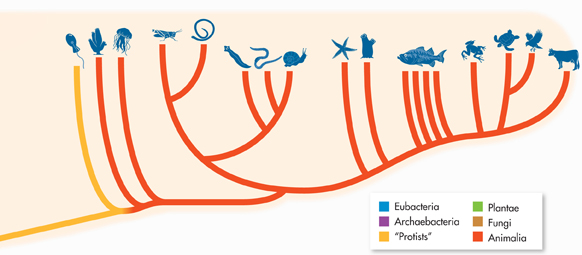
DOMAIN EUKARYA
The domain Eukarya consists of all organisms that have cells with nuclei. It is organized into the four remaining kingdoms of the six-kingdom system: Protista, Fungi, Plantae, and Animalia.
THE “PROTISTS”
Notice that the branches for the kingdom Protista are not together in one area, as is the case with the other kingdoms. In fact, recent molecular studies and cladistic analyses have shown that “eukaryotes formerly known as Protista” do not form a single clade. Current cladistic analysis divides these organisms into at least six clades. They cannot, therefore, be properly placed into a single taxon.
FUNGI
Members of the kingdom Fungi are heterotrophs. Most feed on dead or decaying organic matter. The most recognizable fungi, including mushrooms, are multicellular. Some fungi, such as yeasts, are unicellular.
PLANTS
Members of the kingdom Plantae are autotrophs that carry out photosynthesis. Plants have cell walls that contain cellulose. Plants are nonmotile—they cannot move from place to place.
ANIMALS
Members of the kingdom Animalia are multicellular and heterotrophic. Animal cells do not have cell walls. Most animals can move about, at least for some part of their life cycle.
Table of Contents
- Formulas and Equations
- Applying Formulas and Equations
- Mean, Median, and Mode
- Estimation
- Using Measurements in Calculations
- Effects of Measurement Errors
- Accuracy
- Precision
- Comparing Accuracy and Precision
- Significant Figures
- Calculating With Significant Figures
- Scientific Notation
- Calculating With Scientific Notation
- Dimensional Analysis
- Applying Dimensional Analysis




